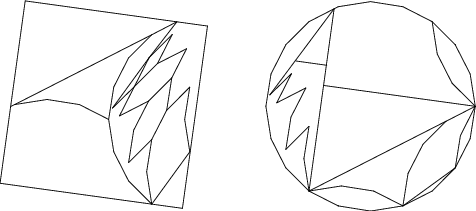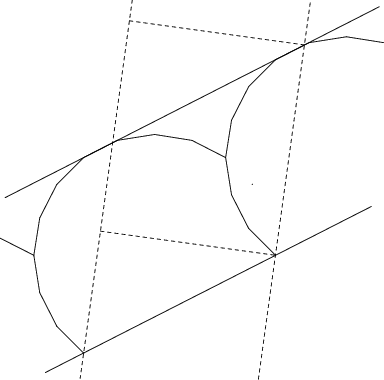In the commentary for Plate 138, I should have "a regular (20-sided) icosagon"
rather than "a regular (24-sided) icosagon".
Before the release of the book, Gavin Theobald had already improved his dissection
of an icosagon to a square. If you thought that a 13-piece dissection in Figure 138b was amazing,
take a look at Gavin's new 11-piece dissection. Gavin's technique also improves
other dissections of many-sided polygons, though so far no others that Ernest Freese had attempted.
Note that the leftmost piece in the isosagon has a very thin neck.
It stretches across an arc of 6 exterior edges plus almost all of a 7th exterior edge of the icosagon.

At the heart of Gavin's dissection is the crossposition below.
What Gavin crossposes is a rectangle whose height is equal to the side length of the desired square.
The width of the rectangle is smaller than the side length of the square,
reflecting the subtraction of the area of five pieces, namely
a very thin isosceles triangle,
a very flat rhombus, two "flattened hexagons,"
a somewhat irregular heptagon.
Let's call them the five friends.
Gavin's uses his crossposition to produce four pieces,
three of which find their way whole into the dissected square.
The miracle of Gavin's dissection is that he found a way to split up the fourth piece
into three pieces so that those three pieces plus the five friends
fill in precisely the right-hand side of the square. Wow!

During the period after I sent in the manuscript for printing,
Gavin Theobald had some wonderful breakthroughs for dissecting many-sided regular polygons to squares.
He further refined his technique for separating two ziggy-zaggy pieces so that rhombuses, flattened hexagons, and other such "friends" could be inserted between a pair of separated ziggy-zaggy pieces. So in addition to his reduction of his number of pieces for an icosagon to a square from 13 down to 11, he also reduced his number of pieces for a hexadecagon to a square from 11 down to 10, and his number of pieces for a icositetracagon to a square from 13 down to 12.
You can find the latest improvements in these dissections by following links from
this webpage .
It includes a prettier icosagon-to-square dissection than the one above,
as well as remarkable dissections for a lot of many-sided dissection problems that Ernest Freese
never considered!
Copyright 2018, Greg N. Frederickson.
Permission is granted to any purchaser of
Ernest Irving Freese's Geometric Transformations:
the Man, the Manuscript, the Magnificent Dissections!
to print out a copy
of this page for his or her own personal use.
Last updated February 6, 2018.

